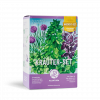
table of contents
- Moth species from B to E
- From G to K
- From L to M
- From P to W
- frequently asked Questions
Moths are often used to describe different pests whose larvae eat different supplies or different textiles. In Germany, however, there is a long list of different species of moth that colonize different habitats.
In a nutshell
- The list of native moth species is getting longer and longer as more and more introduced species are establishing themselves
- Moth species can be found among a wide variety of butterfly families, and the common borer is one of them
- Compared to other butterflies, moths are very small and usually delicately built
- Different types of moth such as the dried fruit moth or the flour borer are often referred to as “food moths”
- not all species of moth are pests
Moth species from B to E
Batia lunaris
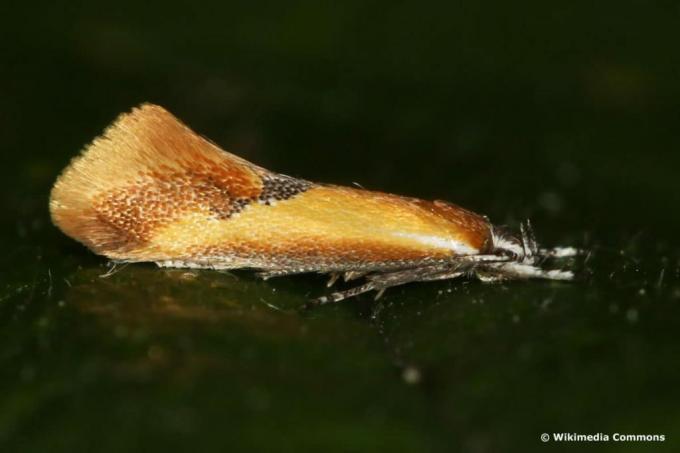
- Size: 7 to 10 mm
- Appearance: forewings golden yellow, black band in the middle, dark body
- Occurrence: Forests and forest edges with dense shrubbery, parks, gardens
- Flight times: June to July
- Caterpillar food: lichens
Box tree moth (Cydalima perspectalis)
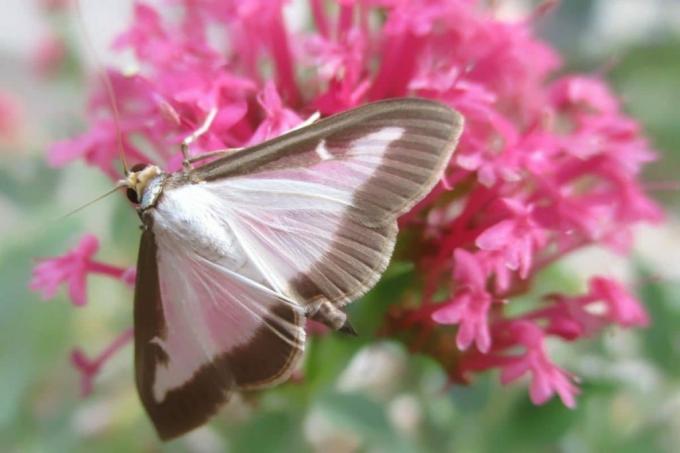
- Size: 40 to 46 mm
- Appearance: wings glossy white with a light brown edge
- Occurrence: Settlement areas with box trees
- Flight times: April to September
- Caterpillar food: boxwood
The box tree moth is not a native species of moth. The insect was introduced and quickly catapulted itself to the top of the list of insect pests, as it greatly reduced the populations of boxwood. So far there are hardly any effective methods for sustainable Combat. Occasionally, bird species use the caterpillars as a source of food. Bats also count the nocturnal moths in their food spectrum.
Dried fruit moth (Plodia interpunctella)
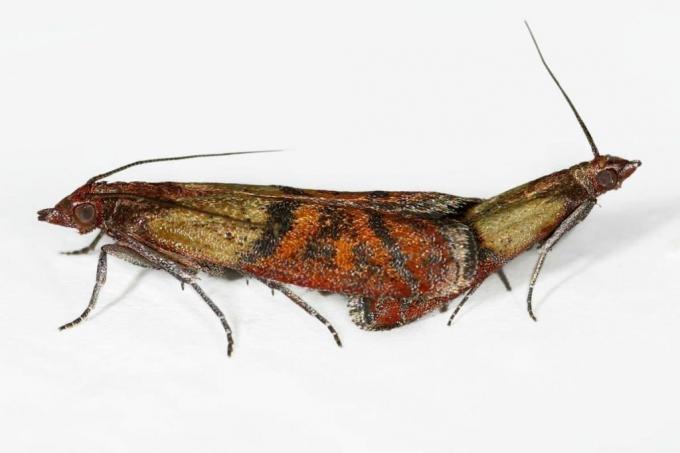
- Size: 13 to 20 mm
- Appearance: wings dark brown and shiny metallic, forewings with a lighter cross-band
- Occurrence: almost exclusively indoors
- Flight times: all year round
- Caterpillars: dried fruits, seeds, cereals, pasta, nuts
Real clothes moth (Tineola bisselliella)
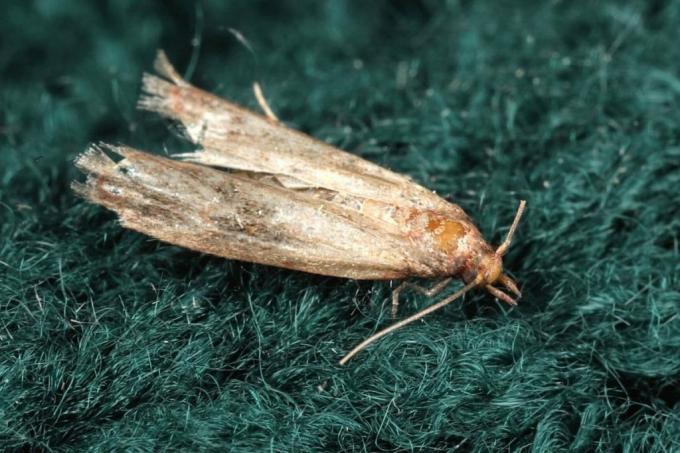
- Size: 9 to 16 mm
- Appearance: wings yellowish to brownish, shiny
- Occurrence: predominantly in buildings, occasionally also populating bird nests and animal structures
- Flight times: all year round indoors
- Caterpillar food: Keratin as found in hair, feathers, wool and flakes of skin
Common oak moth (Dyseriocrania subpurpurella)
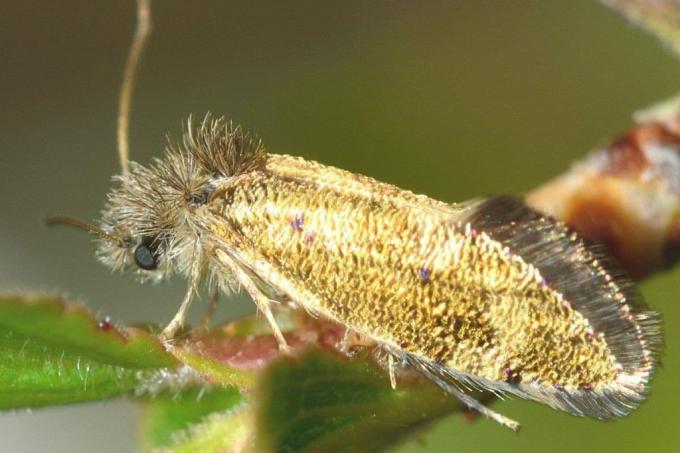
- Size: 6 to 9 mm
- Appearance: forewings brown with purple spots, shiny, hind wings brown-violet
- Occurrence: Forests with dense oak stands
- Flight times: April to May
- Caterpillar food: oak leaves, recognizable by the leaf mines
Emmelina monodactyla
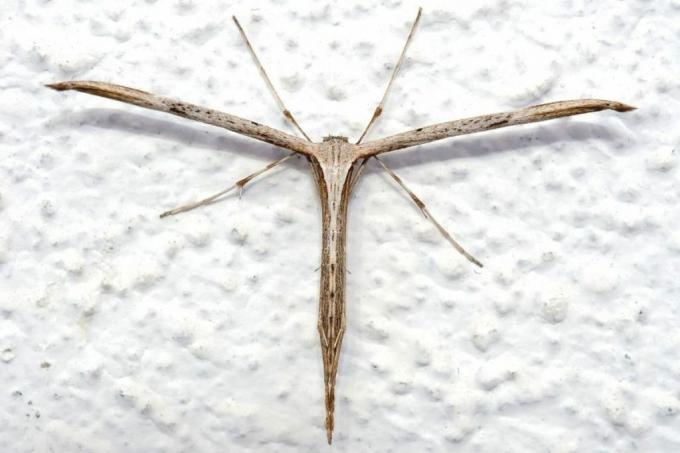
- Size: 18 to 26 mm
- Appearance: wings split in a T-shape, beige to red-brown wings, occasionally with black dots
- Occurrence: in different biotopes, mainly with an open structure
- Flight times: March to September
- Caterpillar feed: different types of bindweed
Note: Among the moth species that are native, Emmelina monodactyla is easy to spot because of its unusual wing shape. The caterpillar forage plants are not common in nature, which is why they occasionally switch to other species such as the goosefoot.
From G to K
Large wax moth (Galleria mellonella)
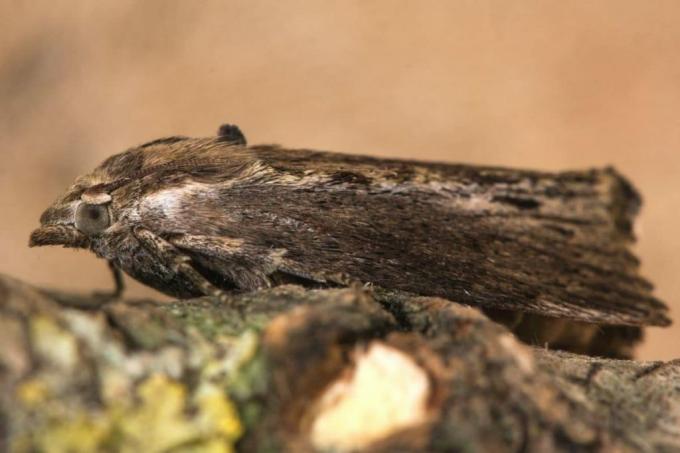
- Size: 30 to 40 mm
- Appearance: wings gray-brown, inconspicuous
- Occurrence: near beehives
- Flight times: May to October
- Caterpillar food: pollen residues, beeswax
The wax moth is a pest around beehives, especially when it occurs in large numbers, and it can also harm the bee colony.
Tip: Hygiene in the beehive is important to prevent intrusion. This includes, for example, removing old wax residues and other waste products from the beehive.
Horn moth (Ceratophaga vastella)
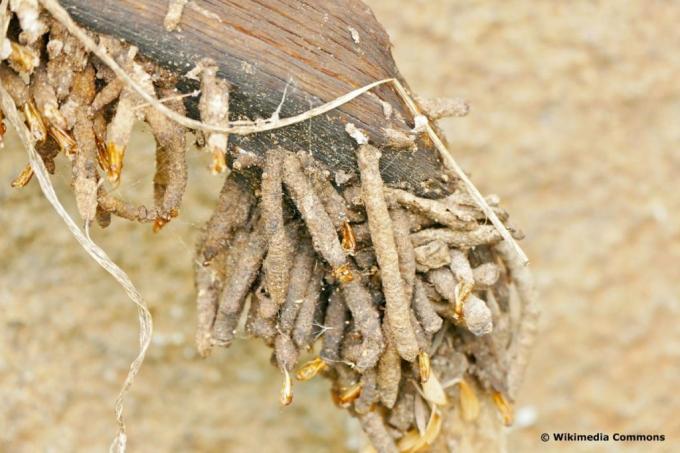
- Size: 19 to 20 mm
- Appearance: golden-yellow forehead, forewings dark gray-brown, hind wings whitish to gray
- Occurrence: indoors
- Flight times: all year round
- Caterpillar food: horns
The horn moth can be recognized by the fact that there are small holes in the horns of hunting trophies, for example. Their damaging effect is so great that they can completely destroy horns within a few weeks.
Note: The species is often not recognized correctly because the holes are similar to the damage caused by eating by woodworms, and thus It is often wrongly assumed that it is the house goat, but that it is made entirely of wood nourishes.
Currant moth (Lampronia capitella)
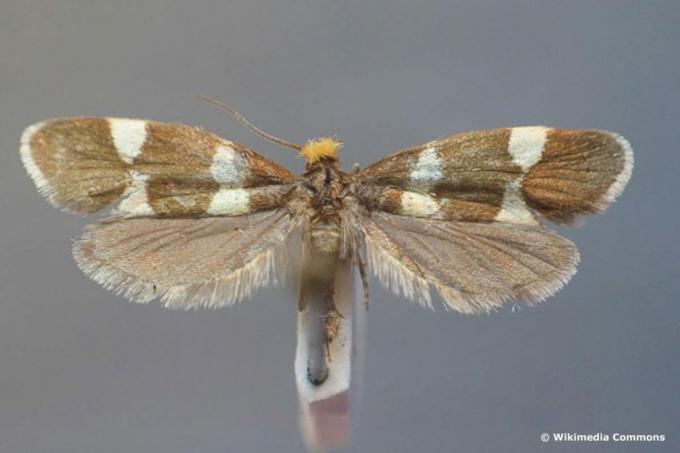
- Size: 14 to 18 mm
- Appearance: orange tufts on the head, forewings dark brown with three white wedges, hind wings gray-brown
- Occurrence: only where currants grow
- Flight times: April to June
- Caterpillar food: currants
The currant moth is one of the most common native pests on currants. An infestation can usually only be recognized in spring, as the overwintered caterpillars drill into the shoots and eat them from the inside out and pupate in them. However, their development begins in the still green currants.
tip: You can prevent the currant moth from spreading if you do not leave the infected fruit lying on the spot, but dispose of it and the infected buds in the general waste.
Cocoa moth (Ephestia elutella)
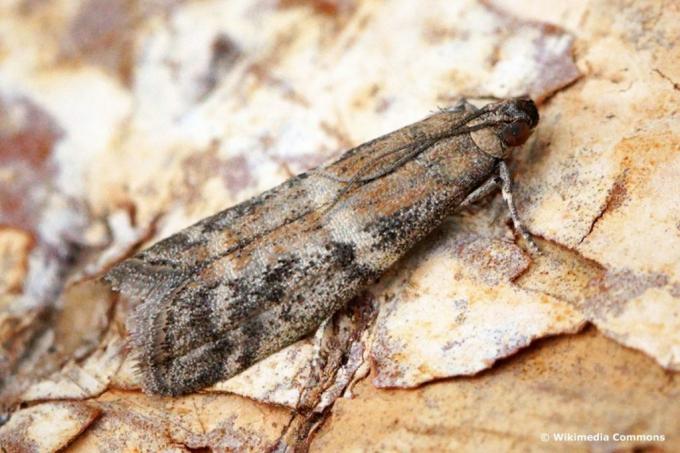
- Size: 10 to 12 mm
- Appearance: forewings gray-brown with somewhat darker transverse bands, hindwings lighter
- Occurrence: indoors
- Flight times: all year round
- Caterpillar foods: cereals, nuts, seeds, various dried vegetable material
The cocoa moth was not originally native to Europe, but was introduced with cocoa beans. However, she is flexible about her diet and eats other foods as well, including hay and straw.
Tip:Fighting the cocoa moth with parasitic wasps promises quick success.
Corn moth (Nemapogon granellus)
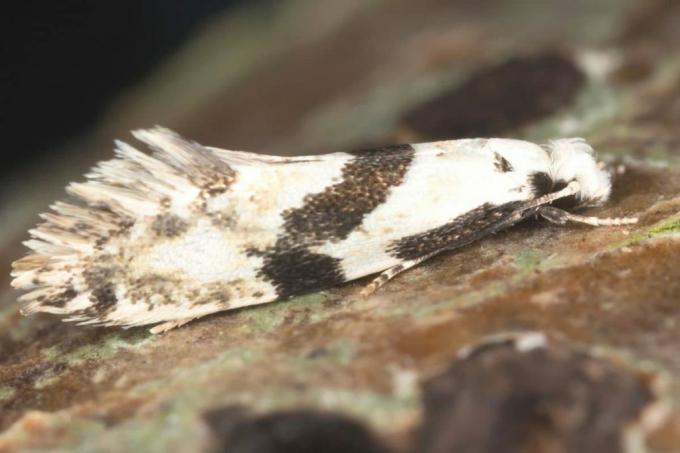
- Size: 5 to 6 mm
- Appearance: forewings white-brown, forehead with white scales
- Occurrence: to be found in different biotopes, also in buildings
- Flying times: May to September, all year round indoors
- Caterpillar food: mold
Note: The corn moth can be easily recognized by its white-brown forewings. In the strict sense of the word, it is not a pest, but rather indicates that grain has been stored incorrectly and that mold infestation has therefore occurred.
From L to M
Longhorn moth (Adela reaumurella)
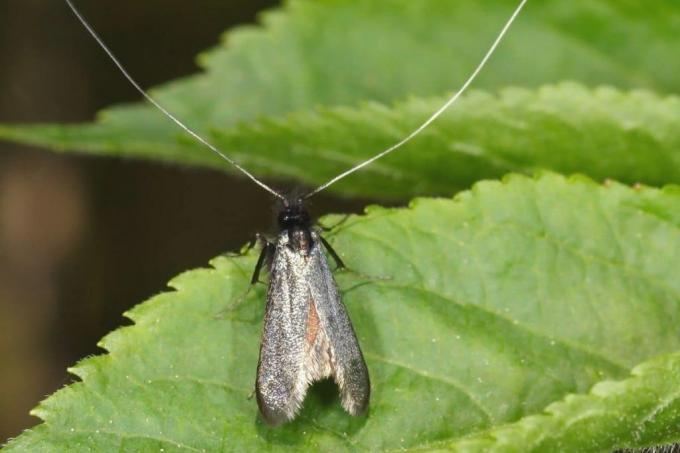
- Size: 14 to 18 mm
- Appearance: forewings shiny, silvery, hindwings blue-violet, edge lighter and fringed, long, light antennae
- Occurrence: forest edges, hedges, light deciduous forests
- Flight times: April to May
- Caterpillar food: withered and dry leaves of various deciduous trees
European corn borer (Ostrinia nubilalis)
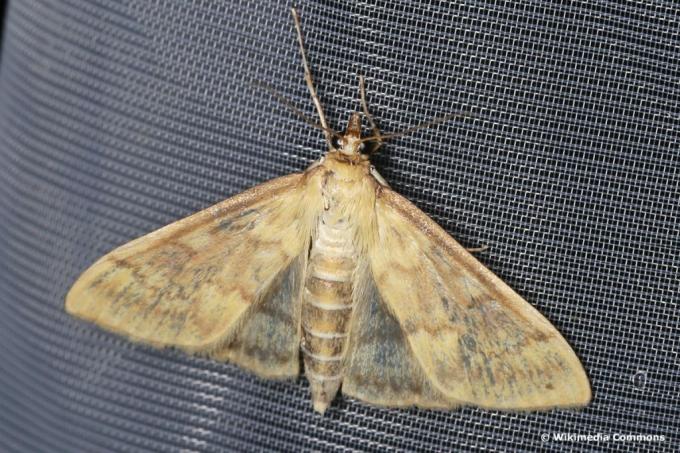
- Size: 20 to 25 mm
- Appearance: wing color very variable, cream-colored, brick-red, light to dark brown, two to three transverse lines
- Occurrence: fields
- Flight times: May to September
- Caterpillar food: mainly maize, now also found on other crops such as hops, potatoes or buckwheat
The European corn borer is not native and was brought to Europe with grain deliveries. In agriculture, it is one of the main pests in maize cultivation and a cultivation especially at Larger areas are usually no longer possible without the use of pesticides against the European corn borer possible.
Flour moth (Ephestia kuehniella)
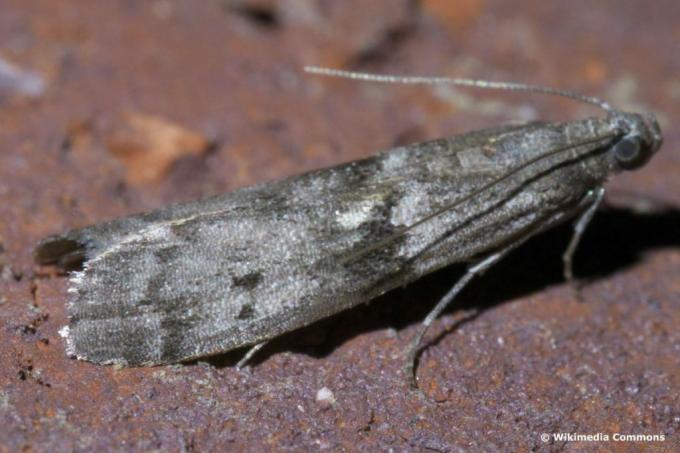
- Size: 10 to 14 mm
- Appearance: forewings beige-gray with black small spots, hind wings dirty white with indented light brown edge line
- Occurrence: in buildings
- Flight times: all year round
- Caterpillar foods: flour, cereals, cereal products
Meatbone (Pyralis farinalis)
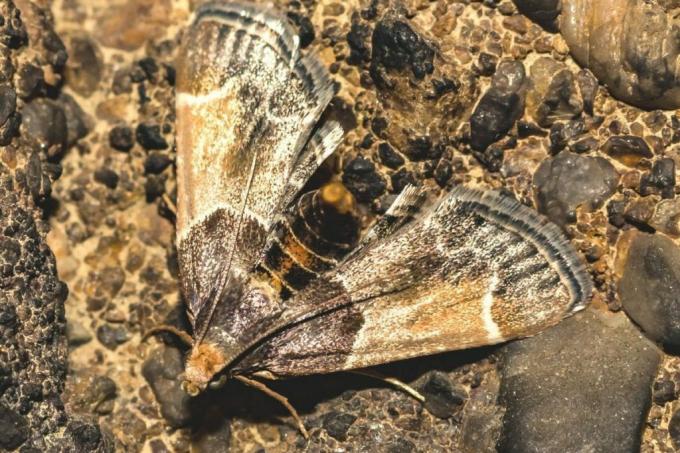
- Size: 18 to 30 mm
- Appearance: wings in different shades of brown, which are interrupted by white transverse lines
- Occurrence: wherever large quantities of grain are stored or processed
- Flight times: all year round
- Caterpillar food: cereals and cereal products, occasionally also grass seeds
Monopis laevigella
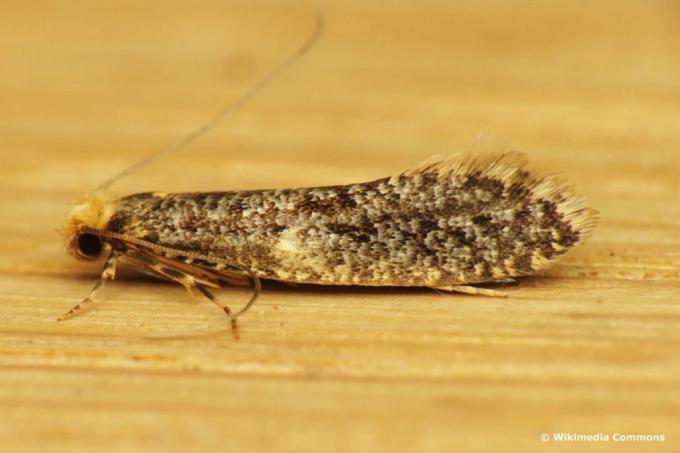
- Size: 5 to 10 mm
- Appearance: golden-yellow scale hairs on the head, front wings black-brown, light-colored scales, rear wings gray-white
- Occurrence: to be found in different biotopes
- Flight times: March to September
- Caterpillars: Food containing keratin, such as hair or feathers, can corrode fur coats
From P to W
Fur moth (Tinea pellionella)
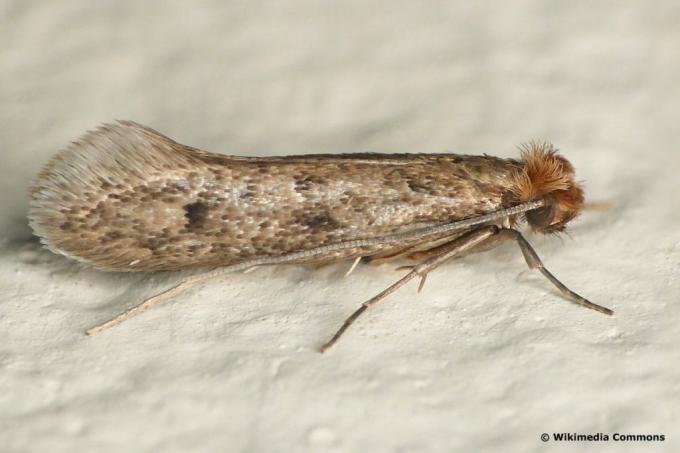
- Size: 5 to 6 mm
- Appearance: yellowish fore wings with three black points
- Occurrence: indoors
- Flight times: all year round
- Caterpillar food: furs, hair and feathers of mammals, animal preparations
Note: The fur moth is declining in Europe, which is mainly due to the fact that for animal welfare reasons more and more real ones are being put through artificial fur.
Red and silver longhorn moth (Cauchas rufimitrella)
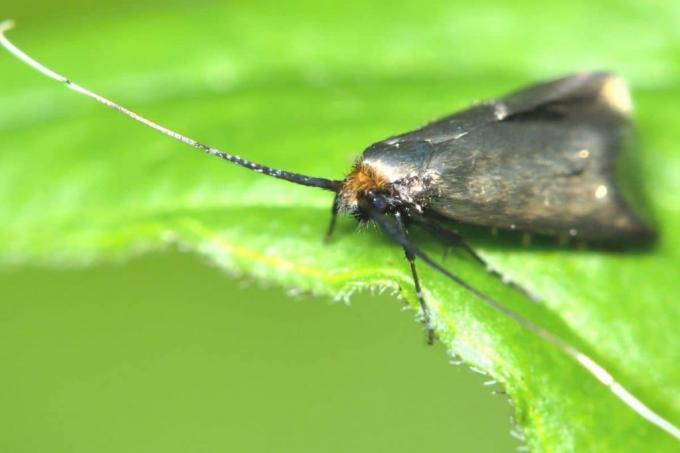
- Size: 10 to 12 mm
- Appearance: wings bronze-colored, shiny metallic, occasionally with a slight green cast, black antennae
- Occurrence: meadows, forest edges
- Flight times: July to September
- Caterpillar food: mainly cruciferous vegetables such as cuckoo herb, garlic mustard or rockcress
Note: In Germany, this type of moth is on the decline as the caterpillars find fewer and fewer forage plants. Occasionally they switch to other biotopes if they find cruciferous vegetables there that start in July or July. bloom until September.
Tinea trinotella
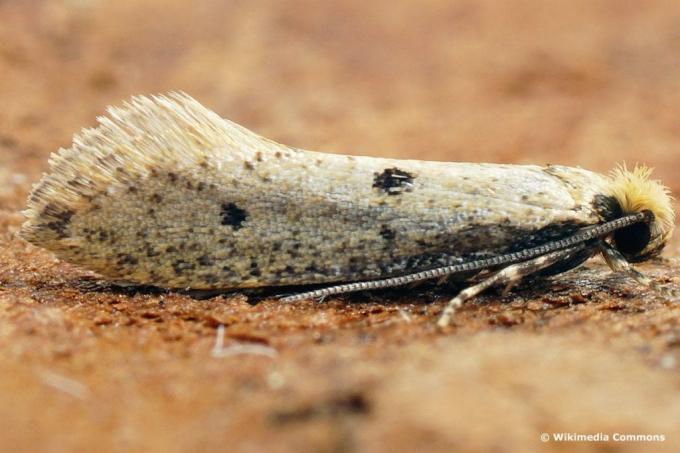
- Size: 12 to 18 mm
- Appearance: forewings yellowish-gray to gray with three black points, hindwings gray-white, orange-colored tufts on the head
- Occurrence: to be found in different biotopes
- Flight times: April to August
- Caterpillar food: various organic substances, mainly dead material in the area of bird nests
Bindweed feather moth (Pterophorus pentadactyla)
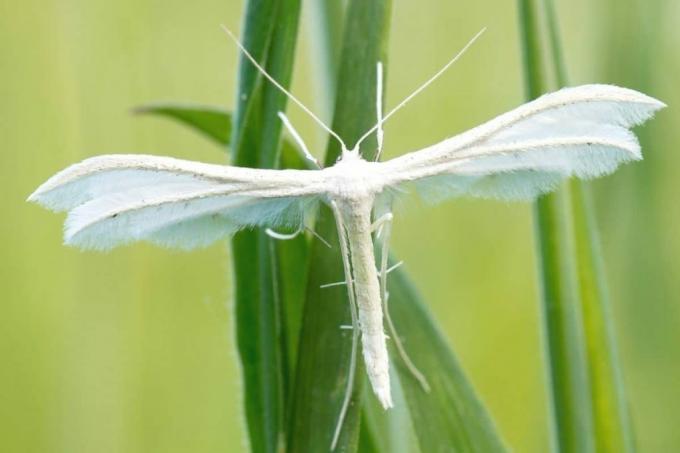
- Size: 25 to 35 mm
- Appearance: feather-like wings, white
- Occurrence: large meadows
- Flight times: June to October
- Caterpillar food: bindweed
It is the largest species of moth that is indigenous, but only rarely shows itself, as its habitats with suitable forage plants are becoming less and less due to intensive management.
Note: The feather moth is colloquially known as the "feather spirit" because of its appearance.
frequently asked Questions
Yes, many species belong to the moth group, but some are also active during the day. The moths among the moths are often attracted to light and it is also easier to catch pests.
Yes, if the temperature indoors is high enough, storage pests in particular are active all year round.
As a rule, male and female species of moth are the same. Occasionally there is minimal difference in height or the intensity of the coloring.
Basically, you shouldn't eat contaminated food any more, but dispose of it immediately. Also make sure that the moths can no longer find food sources. There are different means of combating this in Germany. Pheromone traps have the disadvantage that they can also attract moths that enter through open windows. It is much better to control larvae with parasitic wasps, as there are no more subsequent generations.



